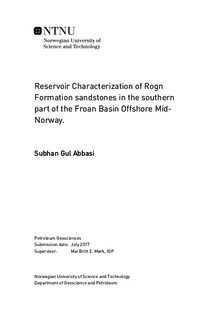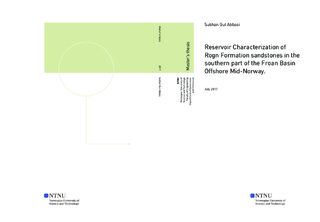| dc.description.abstract | Jurassic reservoirs offshore mid- Norway are of extreme importance in the Norwegian oil and gas sector. Petrophysical logs and thin sections of two cores from southern Froan Basin (Offshore mid-Norway) are investigated to understand the lithology, texture, sorting, grain size, reservoir properties and factors effecting these properties of the Rogn Formation sandstone. Petrophysical log data is used to interpret the lithology and calculate porosity/permeability of the interpreted lithology. Optical microscopy, XRD and modal analysis data is concatenated to explain rock types, grain size, texture, sorting, reservoir properties and diagenetic effects. The results from both methods are integrated and interpretations are made.
The sandstones unit is distinguished from the enclosing dark shales of the Spekk Formation in the petrophysical logs. The petrophysical logs are divided in to different zones based on different log responses. The sandstones are both texturally and compositionally sub mature to immature, and classifying as arkosic to subarkosic sandstones. The arkosic sandstone contains low mica and high microcline content whereas, sub-arkosic sandstone has a thickness of about 12 (m) and contains quartz, feldspar and high mica content. A general coarsening upward trend is established and the whole unit shows good reservoir properties with porosity ranging from 18 to 30% and permeability up to 340 milli-Darcy as calculated from petrophysical data.
The major factors effecting the reservoir properties are calcite cementation and authigenic clay cements. Early calcite cementation filled the primary pores and reduced the porosity of sandstone but also reduced the rate of mechanical compaction and obstructed quartz cementation to preserve porosity. Kaolinite is the abundant clay mineral and is formed because of feldspar alteration and dissolution. During uplifting episode, the meteoric water reacted with the Rogn Formation sandstone and late calcite cementation filled these secondary pores. Although the reservoir shows good properties, no hydrocarbon zone is identified from the logs in the study. | |

